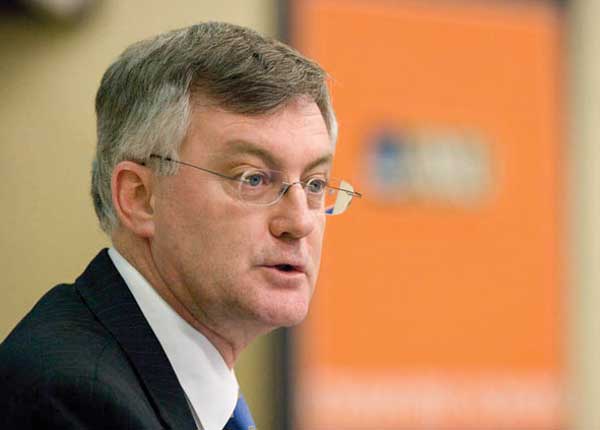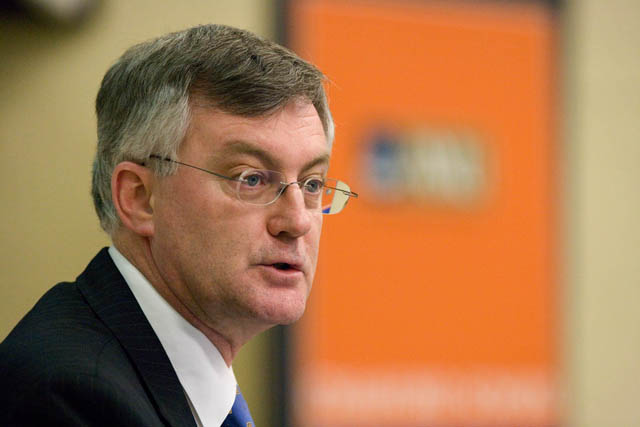

Treasury Secretary Dr Martin Parkinson has gone in to bat for Australia’s fast shrinking ranks of public servants, using a keynote speech to the Institute of Public Administration to caution of a “growing gap between what the community expects from government, and what government can sustainably provide.”
Due to formally depart his post in July after the delivery of the Abbott government’s pivotal first Budget in May, the Treasury chief’s warning has underscored growing concern in the public service that plans for ambitious reforms in service delivery and new policy initiatives are at risk of being derailed because agencies are being increasingly forced to make wholesale cuts to headcount.
Mr Parkinson’s departure is widely seen by the public service and in industry as having been unnecessarily forced at the behest of the Prime Minister and Treasurer Joe Hockey against strong advice to avoid politicising the key post.
In his speech the Treasury chief made it clear that he was not the only person leaving one of Australia’s most highly regarded public institutions.
“Over the past century, we [Treasury] have grown to a peak of just over 1000 staff in March 2011, but now have to shed one in three positions by 2016-17, Dr Parkinson said.
“One of the changes pressing on us is the rising expectation the public has of government and, in turn, the Government has of the public sector.”
The Treasury chief added “that, of course, impacts on what is expected of the public service.”
The overt concern about the divergence of public and political expectations over actual capacity to deliver is certain to be interpreted as a strong signal that brute force job shedding in the Australian Public Service could produce a number of serious but unintended consequences that hamper longer term efficiency gains and reforms.
One obvious problem is that if too many jobs are cut from areas that are driving reforms, the impetus for change can stall and significantly hamper or squander progress that has taken several years to achieve.
A big problem across many government agencies has been achieving consistency across administrative and back office functions so that systems like payroll, human resources and finance as well as databases are not created in isolated and incompatible silos that are costly to maintain or upgrade individually.
Because many of those kinds of projects use contracted or non-permanent staff, they are typically the first areas hit when hiring freezes and retrenchment rounds are applied.
In his speech to fellow public servants, Dr Parkinson issued a firm caution over the potentially negative effects blanket cuts can have on finding more innovative and creative ways to generate efficiency.
Speaking to the target of around a third for Treasury’s staff reduction, Dr Parkinson said “We have already shed about 15 per cent of staff, so we are half way there.”
“Clearly, since we don’t control the responsibilities given to us by Government, change of this magnitude means delivering similar outcomes in a very different manner. In the past, our response to increased demands was to increase our efforts: by working harder and longer,” he said.
“Needless to say, this is not sustainable, and it also crowds out any attempts to think differently – and smarter – about prioritising our resources.”
One of the areas that public servants are known to have real concerns about future service delivery is around innovation and finding ways to harness the kinds of efficiencies now being experienced in the private sector through digitising transactions and using data analytics to spot patterns of behaviour in areas ranging from fraud to call centre queues.
The big payoff for many private sector businesses, like banks, airlines and retailers, has been a step shift improvement in capacity utilisation and resource efficiency that in turn amplifies the return on new investment for dollars spent – as opposed to the high cost of maintaining legacy systems.
Much of that new productivity has been realised by employees being able and allowed to work from mobile devices or access systems remotely when they are on the road.
Dr Parkinson flagged Treasury’s own pursuit of more flexible workplace arrangements in terms of hours and location as a case-in-point.
He said following a capability review there had been “mainstreaming [of] flexible working arrangements within the Treasury.
“We have committed to an ‘if not, why not?’ approach, whereby staff may change their working arrangements unless there is a clear business reason why that would not be suitable, Dr Parkinson said.
Meanwhile, the Community and Public Sector Union immediately seized on Dr Parkinson’s speech as proof of the damage public sector retrenchments are doing.
CPSU National Secretary Nadine Flood said Dr Parkinson was “right to highlight the impact deep public service cuts are having on the bureaucracy’s ability to do its job.”
“When Martin Parkinson says public service can no longer ‘sustainably provide’ services the community expects you have to sit up and take notice. We strongly endorse his comments.”
Ms Flood said CPSU members “have been saying for years that the public service is not a magic pudding [and] successive cuts are taking their toll on their ability to deliver the policy and services.”
“You can’t keep cutting jobs and expect the same level of services,” Ms Flood said.
“If this government is seriously considering cutting anywhere between 14,500 and 26,500 jobs then it needs to lower people’s expectations of government,” Ms Flood said.
“The Government can’t say it hasn’t been warned.”
Comment below to have your say on this story.
If you have a news story or tip-off, get in touch at editorial@governmentnews.com.au.
Sign up to the Government News newsletter



